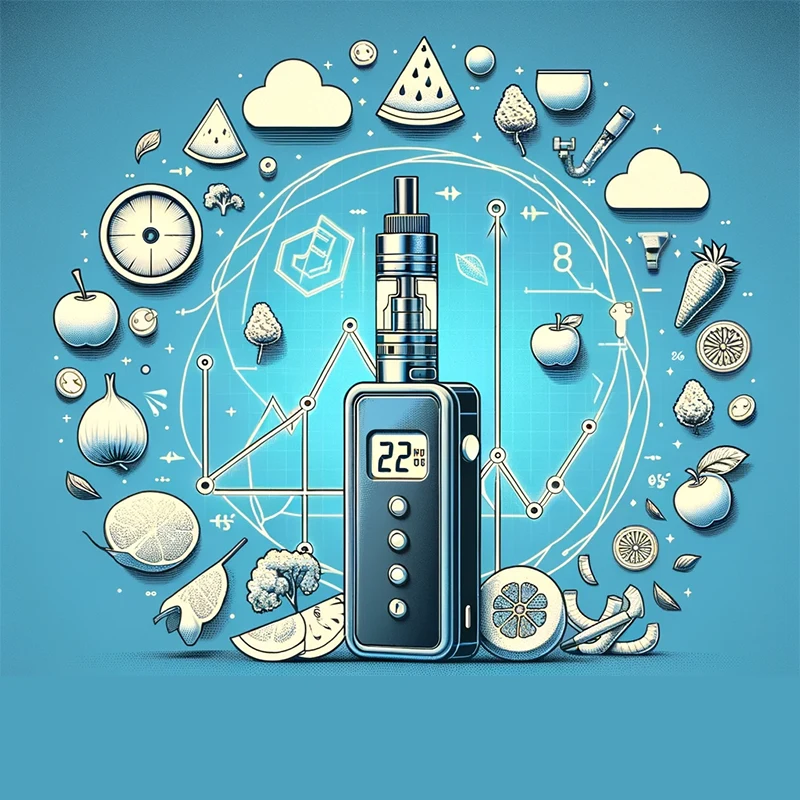Calorie Count in Vaping: Do Vapes Add to Your Daily Intake?
Vaping has become a popular alternative to smoking cigarettes, and for good reason. Vaping is less harmful than smoking and can help people quit smoking altogether. However, many people are still curious about the caloric content of vaping. Do vapes have calories? This article aims to answer that question and provide a better understanding of vapes and their components.
Understanding vapes and their components is important in determining whether they contain calories. Vapes are electronic devices that vaporise a liquid, which is then inhaled. The liquid, known as e-liquid, e-juice or vape juice, is made up of several components, including vegetable glycerin, propylene glycol, flavourings, and nicotine. It is the nicotine content in vape juice that makes it an effective tool for quitting smoking. However, it is the other components that may contain calories.
Caloric content of vaping is a topic of debate among experts. While some e-juices may contain calories, the amount is negligible and not enough to cause weight gain. Furthermore, vaping can actually help people lose weight by reducing their appetite. However, it is important to note that vaping should not be used as a weight loss tool and should be used in moderation.
Contents
Understanding Vapes and Their Components
Vaping has become increasingly popular as an alternative to smoking cigarettes. Vapes, or e-cigarettes, are electronic devices that heat a liquid, known as e-liquid or vape juice, to produce an aerosol that users inhale. E-liquids are made up of several components, including vegetable glycerin, propylene glycol, flavours, and sometimes nicotine.
Components of E-Liquids
Vegetable glycerin (VG) and propylene glycol (PG) are the main ingredients in e-liquids. VG is a sweet, thick liquid that produces large vapour clouds and is responsible for the smoothness of the vape. PG is a thinner liquid that produces less vapour but provides a stronger throat hit. E-liquids often contain various flavours to provide a wide range of taste options. These flavourings are generally food-grade substances that add flavour without adding significant caloric content.
Role of Nicotine
Nicotine is a naturally occurring stimulant found in tobacco plants. It is the addictive component of cigarettes and is also present in some e-liquids. Nicotine in e-liquids is not a significant source of calories. However, it is important to note that nicotine is a highly addictive substance and can have adverse health effects.
Overall, vaping is a popular alternative to smoking cigarettes. E-liquids do not contain significant calories, and the main ingredients, VG and PG, are generally considered safe for consumption. However, it is important to note that the long-term health effects of vaping are still being studied, and individuals should always consult with a healthcare professional before starting to vape.
Caloric Content of Vaping
Do Vape Juices Contain Calories?
One of the most common questions about vaping is whether or not it contains calories. The answer is yes and no. While vape juice does not contain calories in the traditional sense, the two main ingredients in vape juice, vegetable glycerin (VG) and propylene glycol (PG), each have about 4 calories per gram. However, the amount of calories in e-liquid is highly dependent on the manufacturer’s choice of sweeteners. Some sweeteners, such as sucralose, contain calories, while others, such as stevia, do not.
Comparing Vape Juice to Other Products
When compared to other products, such as sugary drinks or snacks, the caloric content of vape juice is relatively low. For example, a 12-ounce can of soda contains an average of 140 calories, while a single serving of potato chips contains around 150 calories. In contrast, a 10ml bottle of vape juice contains around 40-50 calories. It’s also worth noting that vaping is not a replacement for a healthy diet and exercise. While it may be a less calorically dense alternative to sugary drinks and snacks, it should not be relied upon as a weight loss tool.
A 10ml bottle of e-liquid contains approximately 45.92 calories, based on the calculation using the average densities and calorie content of propylene glycol (PG) and vegetable glycerin (VG), the primary ingredients in vape juice. This amount is relatively low, especially when compared to many common food and drink items. However, it’s important to remember that the actual calorie intake from vaping would be even lower, as not all of the liquid is ingested or absorbed into the body during the vaping process.
Overall, while vape juice does contain some calories, the amount is relatively low and should not be a major concern for most vapers. It’s important to remember that vaping is not a replacement for a healthy lifestyle, and should be used in moderation.
Health Implications of Vaping
Vaping has become a popular alternative to smoking, with many people choosing to use e-cigarettes as a way to quit smoking. While vaping is generally considered to be less harmful than smoking, there are still some health implications to consider.
Weight Management and Appetite
One of the concerns that people have about vaping is whether or not it can lead to weight gain. Some people worry that the flavours used in e-cigarettes can stimulate the appetite, leading to overeating and weight gain. However, there is no evidence to suggest that vaping leads to weight gain. In fact, some people have reported that vaping has helped them to manage their weight by curbing their appetite.
Potential Risks of Vaping
It is important to note that the long-term effects of vaping are not yet fully understood. While some studies have suggested that vaping is less harmful than smoking, others have suggested that it may still pose some risks to health. As such, it is important to use e-cigarettes responsibly and to be aware of the potential risks.
Overall, while vaping may have some health implications, it is generally considered to be a safer alternative to smoking. By using e-cigarettes responsibly and being aware of the potential risks, it is possible to enjoy the benefits of vaping without putting your health at risk.
Vaping Versus Smoking
When it comes to smoking traditional cigarettes, weight gain is a common concern for those who quit. However, when comparing vaping to smoking, the impact on weight is less clear.
Calorie Intake and Smoking
Smoking has been shown to reduce appetite and increase metabolism, leading some smokers to worry that quitting smoking will cause weight gain. While it is true that some people may gain weight after quitting smoking, this is not true for everyone. Additionally, the health risks associated with smoking far outweigh any potential weight gain.
Quitting Smoking and Weight
When it comes to quitting smoking, many people turn to vaping as a way to help them quit. While vaping is not risk-free, it is substantially less harmful than smoking. In fact, a UK review found that “in the short and medium-term, vaping poses a small fraction of the risks of smoking” [1].
While some people may gain weight after quitting smoking and turning to vaping, this is not always the case. In fact, some people may find that vaping helps them to manage their weight. For example, vaping can provide a similar hand-to-mouth motion as smoking, which can help to reduce cravings for food.
Overall, while the impact of quitting smoking and turning to vaping on weight is not completely clear, the health benefits of quitting smoking far outweigh any potential risks associated with vaping.
References:
Regulation and Quality of Vape Products
Standards and Safety
In the UK, the sale and marketing of vaping products are regulated by the Medicines and Healthcare products Regulatory Agency (MHRA). The agency ensures that all products meet certain standards of quality, safety, and efficacy. These regulations are in place to protect consumers from harm and ensure that the products they use are of high quality.
Nicotine Strength and Usage
E-juices, also known as vape juices, come in a variety of nicotine strengths. It is important to choose the right strength for your needs. If you are a heavy smoker, you may need a higher nicotine strength to satisfy your cravings. However, if you are a light smoker or a non-smoker, a lower nicotine strength may be more suitable.
It is important to note that nicotine is an addictive substance, and it is important to use vaping products responsibly. Nicotine-free e-juices are available for those who do not want to consume nicotine.
In conclusion, the regulation and quality of vape products in the UK are of high standards. Consumers can be confident that the products they use are safe and effective. It is important to use vaping products responsibly and choose the right nicotine strength for your needs.







Leave a Reply